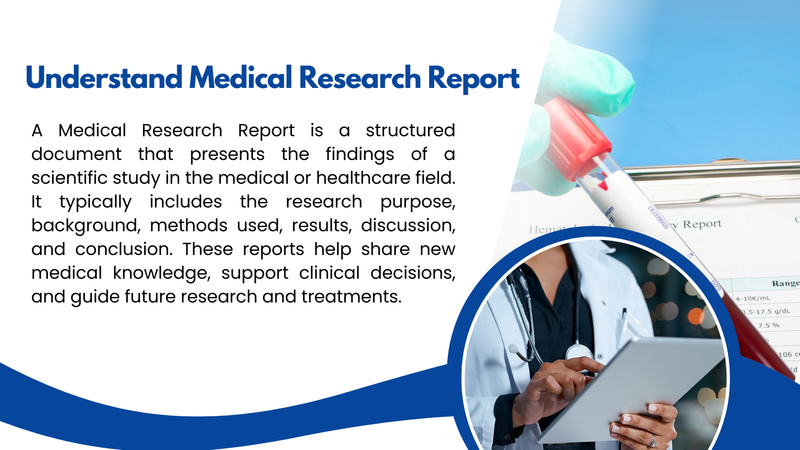Key Takeaways
- For successful publication, it is necessary to understand the peer review process.
- Valid and reliable research depends on accurate data collection and moral reasoning.
- It is important to select the correct magazine to maximize the effects of visibility and research.
Medical research reports are highly significant components of health care literature in terms of building knowledge and improving patient outcomes. Medical research reports establish a conduit between scientific investigation and clinical practice that connects researchers directly to the general medical community as a source of information on certain topics.
Understanding the Structure of a Medical Research Report
This structured approach in preparing a medical research report ensures clarity and professionalism, thus facilitating effective communication of research findings.
A. Title Page
The title page is the first impression your medical research report must make and it should include the necessary information to inform readers about the study. Important elements are:
- Title of the study: It should be clear and concise, and there should be an accurate reflection of the content and purpose of the study. -** Writer Name:** The Contributors contributed to the research.
- Institutional affiliation: Research is conducted by a reputed institution.
- Writer contact information: A contact email or phone number of the lead author, making it easier to communicate with the authors, if further information or possible cooperation is required.
B. Abstract
An abstract usually consists of a 250-300-word summary of the study. In such a case, it is essential to give the reader an overview of what the report contains. A good abstract usually contains:
- Background: A very brief description or introduction of the research problem.
- Objectives: The main goals or hypotheses of the study.
- Methods: Summary of the methodology used.
- Results: Key findings of the study.
- Conclusion: Implications of the results for future research or practice.
C. Introduction
The introduction sets up the context of the research by stating its background and research question. It should:
- State the Research Gap: Introduce previous literature and outline what is left unknown or unexplored;
- State the Importance of the Study: Give reasons why the study is important to the field of medicine or healthcare.
- State the Research Question: Clearly state the specific question or hypothesis the study seeks to answer.
D. Methods
The methods section outlines the study design and methodology in which the study was carried out, making the study transparent and reproducible. This includes:
- Participants: Description of the study population, with requirements for inclusion and exclusion.
- Data Collection Techniques: What data collection techniques were used, and any instruments or tools?
- Statistical Analysis: A list of the statistical procedures adopted to analyze the data, with any specific software used
E. Results
The discussion section should clearly and logically present data and findings that emanate from the study. Such key elements to consider are:
- Presentation of Data: This is through tables, graphs, or charts, with accurate labeling and referencing.
- Summary of Significant Results: A descriptive account that informs me of the significant results, in my own words, without any explanation, strictly based on only what the data shows.
F. Discussion
This is part of the discussion of the findings and what it mean within the discipline of study. It should:
- Interpret the Findings: Explain how one can use the findings to answer the research question or hypothesis.
- Make Comparisons to Previous Research: Make comparisons to other research studies, as well as the differences, and what might account for those differences.
- Consider Limitations: Include the limitations of the study relevant to the interpretation of the findings.
- Recommend Future Research: Identify areas to consider based on the findings that could be researched further.
G. References
References are more important; besides indicating proper citation and reference management, they will allow tracking of the sources cited in the study. Some considerations include:
- Citation Style: To use a certain citation format like APA or AMA, depending on the targeted journal.
- Comprehensive List: Put down all the sources you would have utilized in the report to ensure that every reference is detailed and correct.
- Relevance and Credibility: Ensure that you have used current and reliable sources that give you more credibility to carry on with the research report.
Preparing Your Report
The validity of a medical research report depends on accurate and ethical data collection. Proper methodologies should be used whether data come from clinical trials, surveys, or systematic reviews. Managing medical information efficiently is also essential modern digital solutions for medical records can greatly streamline data organization and improve report quality.
PDF tools further enhance report preparation by helping with editing, merging, and formatting, ensuring the final document is polished and professional.
PDF Tools: Others include clarity, review, etc. However, PDF tools significantly enhance the preparation of medical research reports in the digital age. Editing, merging, and formatting components improve the document's overall quality, making it easier to read and present.
Submission Process
Understanding the submission process, proper journal selection, online platforms navigation, and preparation for peer review would greatly optimize the opportunity to successfully publish and thereby enhance the spread of medical knowledge.
A. Selecting the Right Journal
Choosing the appropriate journal for your medical research report is the most significant step affecting the ability of your work to receive wide visibility and influence. Among the determining factors are
- Target Audience: Consider the journal's audience. Select a journal that reaches your target audience for your research-whether that be accessible to the clinician, researcher, or policymaker.
- Impact Factor and Reputation: This is not the quality barometer; however, it says something about the level of influence of such a journal in the field. Investigate the reputation that this journal holds within the scholarly world to estimate its credibility.
- Read review time and publication frequency: Calculate the average number of days from submission to publication. Some journals are much faster than others; this is an important consideration if the timely dissemination of your work is a priority.
B. Electronic Submission Platforms
Most journals now use electronic submission platforms to make submission easier. Some of the most common platforms include:
- Editorial Manager
- ScholarOne Manuscripts
- Manuscript Central
- PubMed Central
Knowledge of the sites mentioned above means that the submission will likely be much less painful for you and that any technical requirement necessary for the journal to review the paper has been met.
Getting Ready for Peer Review
The entire peer review process is very significant to the flow of academic publishing. It means that research would be reviewed by experts before it is published. Being enlightened on the peer review process will prepare you better.
- The Review Process: Once your manuscript has been submitted, it will normally be reviewed by two or more experts. They check on the validity, significance, and originality of your study, with positive feedback supporting outlining possible revisions.
- Provide feedback: One has to be prepared to be ready to revise the manuscript based on the comments from the reviewer. All the points made by reviewers should be elaborately dealt with along with a considerable response letter in which the changes made or the reason for not making any change has been mentioned.
Concluding Remarks
Preparing and submitting medical research reports are essential processes that meaningfully advance health knowledge and practice. A well-organized report, based on sound ethical data collection, allows for the efficient dissemination of research.







Top comments (0)